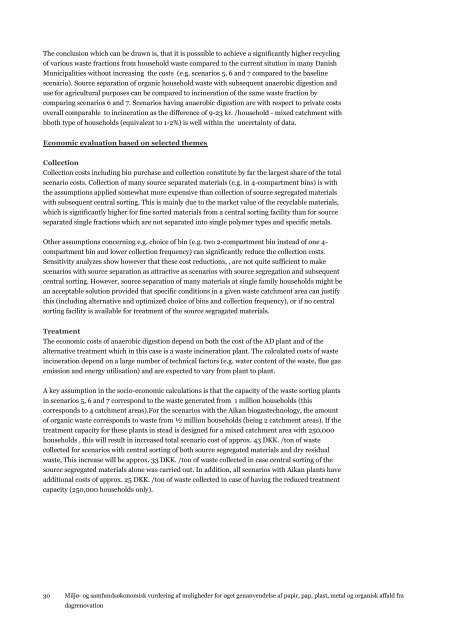Miljø- og samfundsøkonomisk vurdering af ... - Miljøstyrelsen
Miljø- og samfundsøkonomisk vurdering af ... - Miljøstyrelsen
Miljø- og samfundsøkonomisk vurdering af ... - Miljøstyrelsen
You also want an ePaper? Increase the reach of your titles
YUMPU automatically turns print PDFs into web optimized ePapers that Google loves.
The conclusion which can be drawn is, that it is posssible to achieve a significantly higher recycling<br />
of various waste fractions from household waste compared to the current sitution in many Danish<br />
Municipalities without increasing the costs (e.g. scenarios 5, 6 and 7 compared to the baseline<br />
scenario). Source separation of organic household waste with subsequent anaerobic digestion and<br />
use for agricultural purposes can be compared to incineration of the same waste fraction by<br />
comparing scenarios 6 and 7. Scenarios having anaerobic digestion are with respect to private costs<br />
overall comparable to incineration as the difference of 9-23 kr. /household - mixed catchment with<br />
bboth type of households (equivalent to 1-2%) is well within the uncertainty of data.<br />
Economic evaluation based on selected themes<br />
Collection<br />
Collection costs including bin purchase and collection constitute by far the largest share of the total<br />
scenario costs. Collection of many source separated materials (e.g. in 4-compartment bins) is with<br />
the assumptions applied somewhat more expensive than collection of source segregated materials<br />
with subsequent central sorting. This is mainly due to the market value of the recyclable materials,<br />
which is significantly higher for fine sorted materials from a central sorting facility than for source<br />
separated single fractions which are not separated into single polymer types and specific metals.<br />
Other assumptions concerning e.g. choice of bin (e.g. two 2-compartment bin instead of one 4-<br />
compartment bin and lower collection frequency) can significantly reduce the collection costs.<br />
Sensitivity analyzes show however that these cost reductions, , are not quite sufficient to make<br />
scenarios with source separation as attractive as scenarios with source segregation and subsequent<br />
central sorting. However, source separation of many materials at single family households might be<br />
an acceptable solution provided that specific conditions in a given waste catchment area can justify<br />
this (including alternative and optimized choice of bins and collection frequency), or if no central<br />
sorting facility is available for treatment of the source segragated materials.<br />
Treatment<br />
The economic costs of anaerobic digestion depend on both the cost of the AD plant and of the<br />
alternative treatment which in this case is a waste incineration plant. The calculated costs of waste<br />
incineration depend on a large number of technical factors (e.g. water content of the waste, flue gas<br />
emission and energy utilisation) and are expected to vary from plant to plant.<br />
A key assumption in the socio-economic calculations is that the capacity of the waste sorting plants<br />
in scenarios 5, 6 and 7 correspond to the waste generated from 1 million households (this<br />
corresponds to 4 catchment areas).For the scenarios with the Aikan bi<strong>og</strong>astechnol<strong>og</strong>y, the amount<br />
of organic waste corresponds to waste from ½ million households (being 2 catchment areas). If the<br />
treatment capacity for these plants in stead is designed for a mixed catchment area with 250,000<br />
households , this will result in increased total scenario cost of approx. 43 DKK. /ton of waste<br />
collected for scenarios with central sorting of both source segregated materials and dry residual<br />
waste, This increase will be approx. 33 DKK. /ton of waste collected in case central sorting of the<br />
source segregated materials alone was carried out. In addition, all scenarios with Aikan plants have<br />
additional costs of approx. 25 DKK. /ton of waste collected in case of having the reduced treatment<br />
capacity (250,000 households only).<br />
30 Miljø- <strong>og</strong> samfundsøkonomisk <strong>vurdering</strong> <strong>af</strong> muligheder for øget genanvendelse <strong>af</strong> papir, pap, plast, metal <strong>og</strong> organisk <strong>af</strong>fald fra<br />
dagrenovation

















